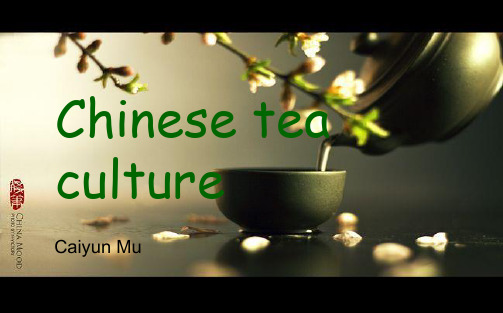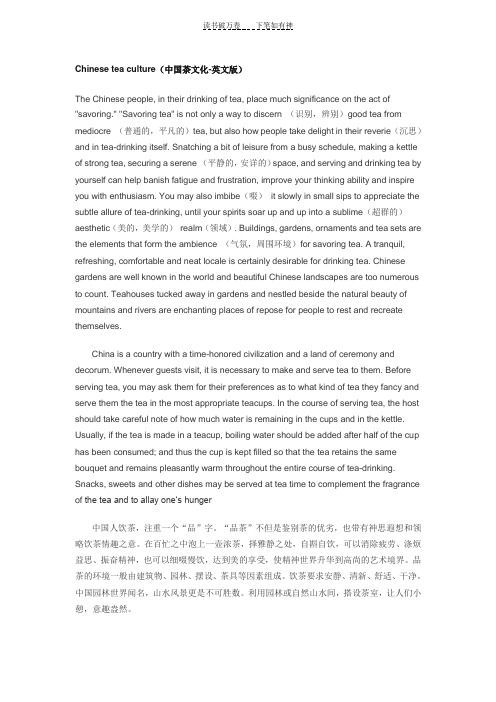中国茶文化英文版完整版解读
- 格式:pptx
- 大小:17.21 MB
- 文档页数:20



中国茶文化英文介绍The Chinese people, in their drinking of tea, place much significance on the act of "savoring." "Savoring tea" is not only a way to discern good tea from mediocre tea, but also how people take delight in their reverie and in tea-drinking itself. Snatching a bit of leisure from a busy schedule, making a kettle of strong tea, securing a serene space, and serving and drinking tea by yourself can help banish fatigue and frustration, improve your thinking ability and inspire you with enthusiasm. You may also imbibe it slowly in small sips to appreciate the subtle allure of tea-drinking, until your spirits soar up and up into a sublime aesthetic realm. Buildings, gardens, ornaments and tea sets are the elements that form the ambience for savoring tea. A tranquil, refreshing, comfortable and neat locale is certainly desirable for drinking tea. Chinese gardens are well known in the world and beautiful Chinese landscapes are too numerous to count. Teahouses tucked away in gardens and nestled beside the natural beauty of mountains and rivers are enchanting places of repose for people to rest and recreate themselves.China is a country with a time-honored civilization and a land of ceremony and decorum. Whenever guests visit, it is necessary to make and serve tea to them. Before serving tea, you may ask them for their preferences as to what kind of tea they fancy and serve them the tea in the most appropriate teacups. In the course of serving tea, the host should take careful note of how much water is remaining in the cups and in the kettle. Usually, if the tea is made in a teacup, boiling water should be added after half of the cup has been consumed; and thus the cup is kept filled so that the tea retains the same bouquet and remains pleasantly warm throughout the entire course of tea-drinking. Snacks, sweets and other dishes may be served at tea time to complement the fragrance of the tea and to allay one’s hunger.参考译文:中国人饮茶,注重一个"品"字。


英文讲解中国茶道文化Chinese Tea Culture: An English IntroductionIntroduction:Tea has been an integral part of Chinese culture for centuries, with its origins dating back to ancient times. In this article, we will delve into the rich history and significance of Chinese tea culture. From the various types of tea to the rituals associated with its preparation and consumption, we aim to provide a comprehensive overview of this fascinating aspect of Chinese heritage.1. History and Origins of Chinese Tea:Tea cultivation in China can be traced back over 5,000 years. Legend has it that Emperor Shen Nong, a mythical figure in Chinese history, discovered the invigorating properties of tea when a tea leaf accidentally fell into his boiling water. Since then, tea has become an integral part of Chinese daily life, from social gatherings to formal ceremonies.2. Types of Chinese Tea:China boasts a wide variety of teas, each with its unique flavor and aroma. Here are some popular types:2.1 Green Tea:Green tea, such as Longjing and Biluochun, is the most common type consumed in China. It is known for its grassy and refreshing taste, as well as its numerous health benefits.2.2 Black Tea:Famous varieties of black tea in China include Dianhong and Keemun. Black tea undergoes a fermentation process, resulting in a robust flavor that is often described as malty or chocolatey.2.3 Oolong Tea:Oolong tea falls between green and black tea in terms of fermentation. Renowned for its complex flavors and floral aromas, Tie Guan Yin and Da Hong Pao are examples of popular oolong teas.2.4 Pu-erh Tea:Pu-erh tea is unique to China and is highly sought after by tea connoisseurs. Made from fermented tea leaves, it develops a rich and earthy flavor over time, with some varieties aged for several decades.3. Tea Ceremony and Etiquette:Tea is not simply a beverage in Chinese culture; it is an art form and a means of fostering social connections. The tea ceremony holds great importance in Chinese traditions, emphasizing mindfulness and respect. Here are some key aspects of tea ceremony etiquette:3.1 Tea Preparation:Tea leaves are delicately chosen and rinsed with hot water to awaken their flavors. The leaves are then steeped at specific temperatures and durations, depending on the type of tea, to ensure optimal taste.3.2 Tea Utensils:Tea sets are essential for the tea ceremony, typically including a teapot, tea cups, and a tea tray. These utensils are often crafted with precision and elegance, showcasing the appreciation for aesthetics in Chinese culture.3.3 Tea Appreciation:Chinese tea ceremonies focus on savoring the tea's aroma, flavor, and color. Participants engage in quiet contemplation as they sip the tea, appreciating its nuances and discussing its qualities. This practice encourages mindfulness and fosters connections among tea lovers.4. Health Benefits of Chinese Tea:Beyond its cultural significance, Chinese tea offers various health benefits. Due to the high concentration of antioxidants, regularly consuming tea has been associated with improving digestion, reducing the risk of cardiovascular diseases, and even helping with weight management.Conclusion:Chinese tea culture, with its long-standing history and profound traditions, offers a unique perspective on the art of tea appreciation. The diverse range of teas, elaborate ceremonies, and health benefits make Chinese tea culture a captivating and enriching experience for tea enthusiasts worldwide. Whether one seeks tranquility or a deeper understanding of Chinese heritage, exploring the world of Chinese tea is indeed a journey worth undertaking.。

Chinese tea culture(中国茶文化-英文版)The Chinese people, in their drinking of tea, place much significance on the act of "savoring." "Savoring tea" is not only a way to discern (识别,辨别)good tea from mediocre (普通的,平凡的)tea, but also how people take delight in their reverie(沉思)and in tea-drinking itself. Snatching a bit of leisure from a busy schedule, making a kettle of strong tea, securing a serene (平静的,安详的)space, and serving and drinking tea by yourself can help banish fatigue and frustration, improve your thinking ability and inspire you with enthusiasm. You may also imbibe(啜)it slowly in small sips to appreciate the subtle allure of tea-drinking, until your spirits soar up and up into a sublime(超群的)aesthetic(美的,美学的)realm(领域). Buildings, gardens, ornaments and tea sets are the elements that form the ambience (气氛,周围环境)for savoring tea. A tranquil, refreshing, comfortable and neat locale is certainly desirable for drinking tea. Chinese gardens are well known in the world and beautiful Chinese landscapes are too numerous to count. Teahouses tucked away in gardens and nestled beside the natural beauty of mountains and rivers are enchanting places of repose for people to rest and recreate themselves.China is a country with a time-honored civilization and a land of ceremony and decorum. Whenever guests visit, it is necessary to make and serve tea to them. Before serving tea, you may ask them for their preferences as to what kind of tea they fancy and serve them the tea in the most appropriate teacups. In the course of serving tea, the host should take careful note of how much water is remaining in the cups and in the kettle. Usually, if the tea is made in a teacup, boiling water should be added after half of the cup has been consumed; and thus the cup is kept filled so that the tea retains the same bouquet and remains pleasantly warm throughout the entire course of tea-drinking. Snacks, sweets and other dishes may be served at tea time to complement the fragrance of the tea and to allay one‘s hunger中国人饮茶,注重一个“品”字。
中国茶文化的英文介绍中国擦痕恶化博大精深,那你们知道中国茶文化的英文介绍吗?下面是店铺精心为你整理的中国茶文化的英文介绍,一起来看看。
中国茶文化的英文介绍The Chinese people, in their drinking of tea, place much significance on the act of "savoring." "Savoring tea" is not only a way to discern good tea from mediocre tea, but also how people take delight in their reverie and in tea-drinking itself. Snatching a bit of leisure from a busy schedule, making a kettle of strong tea, securing a serene space, and serving and drinking tea by yourself can help banish fatigue and frustration, improve your thinking ability and inspire you with enthusiasm. You may also imbibe it slowly in small sips to appreciate the subtle allure of tea-drinking, until your spirits soar up and up into a sublime aesthetic realm. Buildings, gardens, ornaments and tea sets are the elements that form the ambience for savoring tea. A tranquil, refreshing, comfortable and neat locale is certainly desirable for drinking tea. Chinese gardens are well known in the world and beautiful Chinese landscapes are too numerous to count. T eahouses tucked away in gardens and nestled beside the natural beauty of mountains and rivers are enchanting places of repose for people to rest and recreate themselves.China is a country with a time-honored civilization and a land of ceremony and decorum. Whenever guests visit, it is necessary to make and serve tea to them. Before serving tea, you may ask them for their preferences as to what kind of tea they fancy and serve them the tea in the most appropriate teacups. In the course of serving tea, the host should take careful note of how much water is remaining in the cups and in the kettle. Usually, if the teais made in a teacup, boiling water should be added after half of the cup has been consumed; and thus the cup is kept filled so that the tea retains the same bouquet and remains pleasantly warm throughout the entire course of tea-drinking. Snacks, sweets and other dishes may be served at tea time to complement the fragrance of the tea and to allay one's hunger.中国人饮茶,注重一个"品"字。
中国茶文化介绍英文版-课件 (一)China, the origin of tea, has a long-standing tea culturethat has been passed down for thousands of years. As a symbol of Chinese civilization, tea has been integrated into thedaily lives of Chinese people, and its accompanyingceremonies and customs have become increasingly profound.This presentation provides an introduction to the Chinese tea culture, including its history, variety, preparation, and customs.1. History of Tea Culture in ChinaTea has a long history in China, dating back to the Shang Dynasty (1600-1046 BC). It was first discovered in Yunnan Province, where people used it as a medicinal herb. Duringthe Tang Dynasty (618-907 AD), tea became a popular beverage, and the production of tea leaves became an important industry. Tea culture began to develop, and various tea ceremonies and customs were formed.2. Types of Chinese TeaThere are many types of Chinese tea, including green tea,black tea, oolong tea, white tea, yellow tea, and dark tea. Each type has its unique flavor and aroma, and is enjoyed by tea lovers around the world. Green tea is the most popular type, and it is known for its fresh, grassy taste and numerous health benefits.3. Preparation of Chinese TeaThe preparation of Chinese tea is an art form in itself. The water temperature, brewing time, and tea leaf quality all play a role in the flavor and aroma of the tea. Generally, Chinese tea is brewed in small teapots or cups, with the leaves steeped in hot water multiple times. This allows for the flavor and aroma to unfold and intensify with each subsequent infusion.4. Customs of Chinese TeaChinese tea is not only a beverage, but also an important part of Chinese culture. The etiquette surrounding tea drinking is very important, and serves as a means of communication and social interaction. Tea ceremonies, such as the Gongfu tea ceremony, have been performed for centuries, and are enjoyed by tea lovers around the world. Additionally, tea has been integrated into Chinese traditional medicine, and is believed to have many health benefits for the body and mind.In conclusion, Chinese tea culture is an integral part of Chinese civilization, and has been passed down for thousands of years. Its numerous varieties, preparation methods, and customs make it a unique and important art form. As people around the world continue to discover the joys and benefits of tea, the tea culture of China will continue to thrive and grow.。